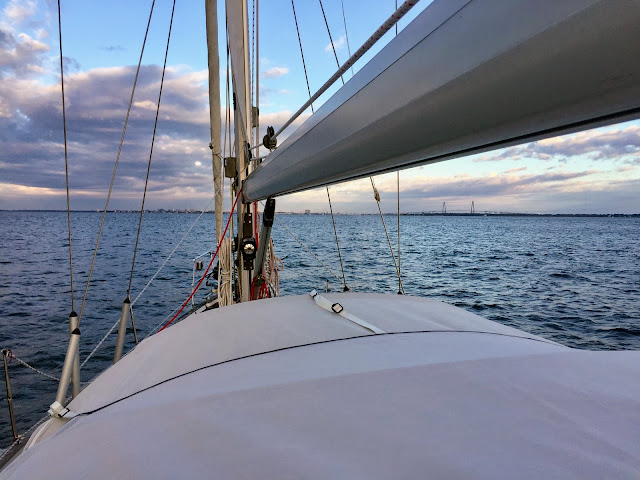We motored for the first few hours until the sun came up, then we raised our headsail since the wind was astern and we were being pushed along by following seas. We had great sailing for more than half of the trip south, but then things started to go in that direction too :), which seems to happen when you are traveling by boat and have a specific destination and arrival time. By midday the waves had grown to 4-6 feet, and the wind had turned further downwind (from directly behind us, which is a slower point of sail), and we grew concerned we weren't making enough progress to hit Wrightsville Beach before dusk. The inlet there is lined by large rock jetties and unlit channel markers, so we needed to visually see to navigate in safely.
So we turned on the engine and motored through strengthening winds and waves, which shifted the next few hours from astern (behind us) to abeam (from the side), which can uncomfortably and dangerously roll the boat from side to side. We did our best to turn the boat away from the largest swells and ride them down - our max hull speed is about 8 kts, and we hit over 10 kts riding down a few waves! - but after 12 hours at sea, and rolling in 6-8 foot seas (according to nearby NOAA buoys), we were mentally and physically exhausted.
We finally arrived at Masonboro Inlet around 4 p.m., and Nick did an amazing job navigating the channel while surfing down 5-6 ft seas from behind, which can make steering and controlling the boat's speed difficult (no actual pictures of this, we were too busy holding on). We were relieved to finally have some calm - and to make it even better - as we made the last turn into the channel, we spotted fins and got an escort in from a small pod of dolphins.
While we were never in any danger (Borealis is made for and well equipped to handle far worse weather conditions), we were weary and fatigued; cruisers often say the highs are high, and the lows are low...and we are starting to get that.
The positive aspects of the trip are that we learned from it: how sea state affects us and the boat and how to better factor that into our passage planning. Also, if we hadn't gone, we would have stayed anchored in Cape Lookout, which was hit with severe weather that night, including a possible tornado in the area, and we would have been right in the middle of it in a pretty unprotected anchorage.
The following day was sunny and warm, so we took the dinghy into town to explore and run some errands. We stayed in Wrightsville for two more days waiting out a low front to pass, with gale winds in the high-30s. During the time, Nick wired and installed a new weatherproof USB port into our helm to keep fully charged the two iPads we use as our primary chart plotters (in addition to our radar/plotter).
We left Wrightsville Beach on November 16 via the ICW and Snows Cut to the Cape Fear River. We decided to take the 20-mile shortcut down the ICW to avoid losing more time sailing 60 miles around Frying Pan Shoals. We ended up in Southport, where we anchored for one night before jumping back offshore on a 136-mile overnight sail down to Charleston, S.C. (We made it over another state line!).
Thankfully, our second offshore passage - and first overnight - was mostly uneventful, despite light winds from astern (we motored for much of the trip) and following seas (again!) that rocked the boat from side to side for more than half the 22-hour trip.
Overnight we took 3-hour watches and tried to grab some rest in between. The first time out in the ocean in the dark, without a cell signal or land in sight is intimidating, so there's a thrill to seeing the first rays of the rising sun glimmering on the horizon, and we arrived in busy Charleston port just as the sun came up (and the wind and swell, which seems to be our luck).
 |
| Strapped in to our makeshift sleeping berth (with a lee cloth) for our offshore passages, which is closer to the cockpit and easier for hearing one another. |
By breakfast we were anchored near Charleston City Marina and napping since we didn't get much rest overnight. We've visited Charleston (by land) on a few occasions, so we decided to move on rather quickly to new and unexplored places.
 |
| Passing Fort Sumter at first light |
 |
| A 200-ft sailboat at the Charleston City Marina |
We left Charleston the following morning along the Stono and Ashepoo rivers for a two-day cruise through low country to Beaufort, S.C. We decided to hop back into the ICW for this stretch rather than go offshore, since it was less mileage and time than going in and out of the two port channels, and it was worth it. The small towns and marshes along the way are very pretty and quiet (except for the many military planes we heard and saw overhead); we also saw dozens of dolphins in the rivers and some of our best sunsets yet.
Back in Beaufort
We are currently in Beaufort, S.C., a lovely little southern waterfront town, on a mooring at the Downtown Marina of Beaufort, where we plan to rest for a few days and spend the Thanksgiving holiday.
 |
| Waiting for our cab at the market, with Thanksgiving provisions (and a pecan pie) in hand! |





















Glad to see you two getting south. it's so easy to stick in those neat little towns. Happy Thanksgiving!!
ReplyDelete